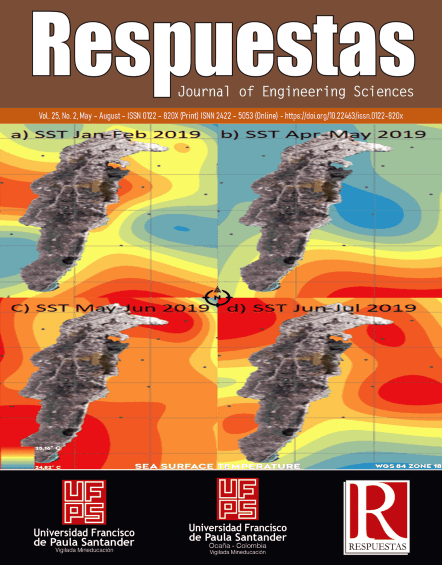Mathematical model of the aquatic phase in the population growth dynamics of Aedes Aegypti contaminated with Wolbachia
Modelo matemático de la fase acuática en la dinámica de crecimiento de la población de Aedes Aegypti contaminada con Wolbachia
Main Article Content
Abstract
Dengue is an infectious disease of global public health significance and is a leading cause of death. A study focusing on the aquatic phase (egg, larva and pupa) of the Aedes aegypti mosquito, with and without Wolbachia, is being conducted. A mathematical model is formulated, the results suggest that the intrinsic ovoposition rate is the parameter that most affects the non-trivial equilibrium solution. As a conclusion, it is suggested that, under certain conditions, the reproduction of Wolbachia-contaminated mosquitoes in the aquatic phase is small compared to the reproduction of wild mosquitoes, which could affect the success of the control strategy.
Downloads
Download data is not yet available.
Article Details
References
L. Esteva y C. Vargas 1998 “Analysis of a dengue disease transmission model”. Mathematical biosciences Vol 150, No 2, pp 131-151.
L. Esteva y H. M Yang 2005 “Mathematical model to assess the control of Aedes aegypti mosquitoes by the sterile insect technique”, Mathematical biosciences Vol 198, No 2, pp 132-147.
R. C. Thomé, H. M. Yang y L. Esteva 2010 “Optimal control of Aedes aegypti mosquitoes by the sterile insect technique and insecticide”. Mathematical Biosciences, Vol 223, No 1, pp 12-23.
S. T. Pinho et al. 2010 “Modelling the dynamics of dengue real epidemics”, Philosophical Transactions of the Royal Society A, Vol 368, No 1933, pp 5679-5693.
C. P. Ferreira 2020 “Aedes aegypti and Wolbachia interaction: population persistence in an environment changing”, Theoretical Ecology, Vol 13, pp 1-12.
R. Taghikhani y A. B. Gumel 2018“Mathematics of dengue transmission dynamics: Roles of vector vertical transmission and temperature fluctuations”, Infectious Disease Modelling Vol 3, pp 266-292.
H. M. Yang y C. P. Ferreira 2008 “Assessing the effects of vector control on dengue transmission”. Applied Mathematics and Computation, Vol 19, No 1, pp 401-413.
D. Cardona-Salgado et al. 2020 “Wolbachia-based biocontrol for dengue reduction using dynamic optimization approach”. Applied Mathematical Modelling, Vol 82, pp 125-149.
H. S. Rodrigues, M. T. Monteiro y D. F. Torres 2013 “Sensitivity analysis in a dengue epidemiological model”, Conference Papers in Science, Vol 2013, Art. ID 721406, 7 pages
J. P. Romero-Leiton y E. Ibargüen-Mondragón 2019 “Stability analysis and optimal control intervention strategies of a malaria mathematical model”. Applied Sciences, Vol 21, pp 184-218
L. Esteva y H. M Yang 2005 “Mathematical model to assess the control of Aedes aegypti mosquitoes by the sterile insect technique”, Mathematical biosciences Vol 198, No 2, pp 132-147.
R. C. Thomé, H. M. Yang y L. Esteva 2010 “Optimal control of Aedes aegypti mosquitoes by the sterile insect technique and insecticide”. Mathematical Biosciences, Vol 223, No 1, pp 12-23.
S. T. Pinho et al. 2010 “Modelling the dynamics of dengue real epidemics”, Philosophical Transactions of the Royal Society A, Vol 368, No 1933, pp 5679-5693.
C. P. Ferreira 2020 “Aedes aegypti and Wolbachia interaction: population persistence in an environment changing”, Theoretical Ecology, Vol 13, pp 1-12.
R. Taghikhani y A. B. Gumel 2018“Mathematics of dengue transmission dynamics: Roles of vector vertical transmission and temperature fluctuations”, Infectious Disease Modelling Vol 3, pp 266-292.
H. M. Yang y C. P. Ferreira 2008 “Assessing the effects of vector control on dengue transmission”. Applied Mathematics and Computation, Vol 19, No 1, pp 401-413.
D. Cardona-Salgado et al. 2020 “Wolbachia-based biocontrol for dengue reduction using dynamic optimization approach”. Applied Mathematical Modelling, Vol 82, pp 125-149.
H. S. Rodrigues, M. T. Monteiro y D. F. Torres 2013 “Sensitivity analysis in a dengue epidemiological model”, Conference Papers in Science, Vol 2013, Art. ID 721406, 7 pages
J. P. Romero-Leiton y E. Ibargüen-Mondragón 2019 “Stability analysis and optimal control intervention strategies of a malaria mathematical model”. Applied Sciences, Vol 21, pp 184-218







